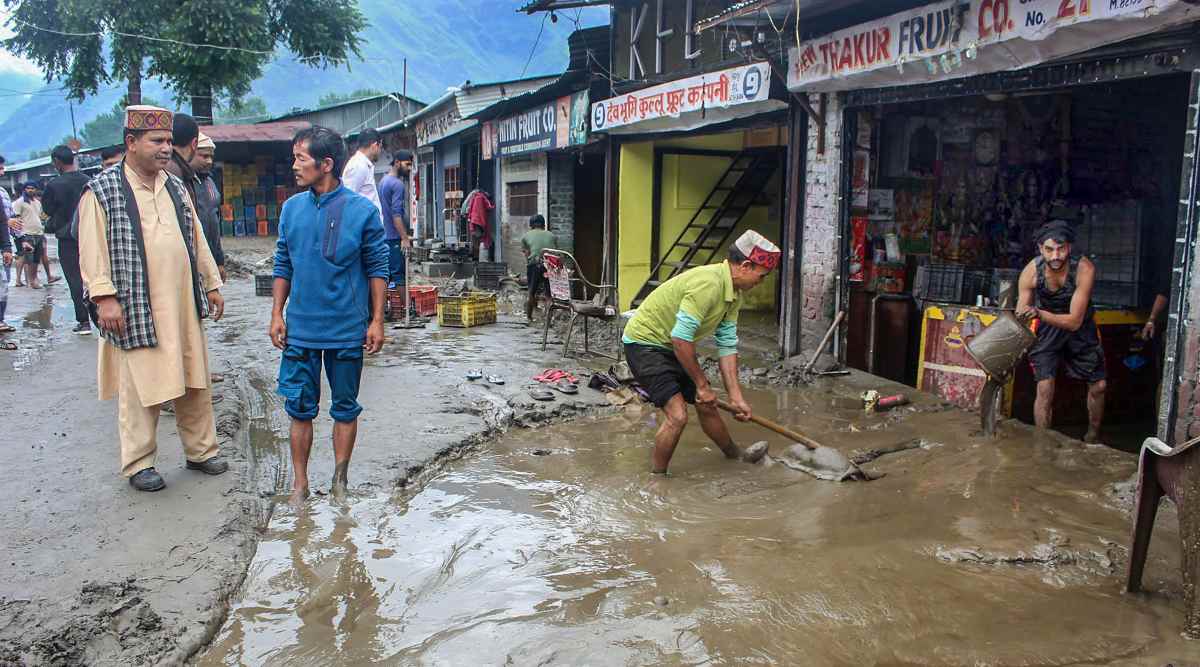Two in three people in India exposed to extreme flood events: Study

Two in three people in India exposed to extreme flood events: Study
The findings of the study conducted by the Council on Energy, Environment, and Water in India are indeed concerning. They reveal a significant disparity between the exposure of India’s population to extreme flood events and the limited coverage provided by early warning systems (EWS).
According to the study, around 66 per cent of India’s population is exposed to devastating flood events. This means that a substantial portion of the population is vulnerable to the destructive impacts of floods, including loss of life, displacement, damage to infrastructure, and economic losses.
However, the study highlights a positive aspect regarding the cyclone early warning system in India. It states that 100 per cent of people residing in cyclone-prone areas, which constitutes 25 per cent of India’s population, are covered by the cyclone EWS. This indicates a robust and comprehensive system to warn and protect people in areas prone to hurricanes, reducing the risks associated with these natural disasters.
Addressing the limited coverage of flood early warning systems is crucial to improve the preparedness and resilience of communities facing flood hazards. It requires concerted efforts from the government, relevant authorities, and stakeholders to invest in and expand the coverage of flood EWS across the country. This includes implementing effective communication channels, utilizing technology and data for early detection and forecasting, and educating and raising awareness among the population about the importance of preparedness and response during flood events.
By strengthening the flood early warning systems and increasing their coverage, the aim is to reduce the vulnerability of communities, save lives, minimize damage to infrastructure, and enhance overall resilience to flood events in India.
The report titled “Strengthening India’s Disaster Preparedness with Technology: A Case for Effective Early Warning Systems” sheds light on the weak flood warning system in Himachal Pradesh, one of the states in India that has been severely impacted by heavy rainfall, leading to casualties and evacuations.
The specific details and findings of the report regarding the weak flood warning system in Himachal Pradesh are not available to me, as my knowledge cutoff is in September 2021, and I need access to the specific contents of the report you mentioned. However, it is not uncommon for certain regions or states to face challenges regarding their disaster preparedness infrastructure and early warning systems.

In the context of Himachal Pradesh, known for its hilly terrain and susceptibility to heavy rainfall and flash floods, having an effective flood warning system is crucial for timely evacuation and preparedness measures to mitigate the impact of such events. Weaknesses in the flood warning system can hinder the ability to provide early alerts to at-risk communities, potentially resulting in higher casualties and more significant damage.
To address these challenges, it is important for relevant authorities in Himachal Pradesh, such as the state government and disaster management agencies, to prioritize the improvement of the flood warning system. This may involve investing in advanced technologies for real-time monitoring of rainfall and water levels, strengthening communication networks to disseminate alerts effectively, and enhancing coordination among various stakeholders involved in disaster response and preparedness.
Additionally, community awareness and education are vital in ensuring that individuals and communities understand the risks associated with floods and are prepared to take appropriate actions when warnings are issued. Public campaigns and training programs can help raise awareness, promote preparedness measures, and facilitate community participation in disaster management efforts.
By addressing the weaknesses in the flood warning system and implementing measures to strengthen disaster preparedness, Himachal Pradesh and other vulnerable regions can enhance their resilience and ability to respond effectively to flood events, reducing the impact on human lives and infrastructure.
The report highlights the importance of expanding the coverage of flood Early Warning Systems (EWS) in India due to the increasing frequency of extreme flood events caused by climate change and erratic weather patterns. As the country faces these challenges, it becomes crucial to ensure that a larger population has access to reliable and effective flood EWS compared to earlier.
The report also provides insights into the resilience of different states in India concerning flood and cyclone events. Out of the 32 states exposed to floods, 14 states are considered highly resilient due to the availability, accessibility, and effectiveness of EWS and Multi-Hazard Early Warning Systems (MHEWS). This indicates that these states have made significant progress in implementing robust systems to warn and protect their populations from flood events.
Additionally, the report highlights the efforts of specific states in building resilience by establishing cyclone EWS. States such as Andhra Pradesh, Odisha, Goa, Karnataka, Kerala, and West Bengal are recognized for developing and implementing effective cyclone EWS. These states have likely invested in advanced technologies, early detection systems, and communication networks to ensure that timely warnings reach vulnerable communities in cyclone-prone areas.
These initiatives demonstrate the importance of proactive measures in enhancing disaster preparedness and response. By establishing and strengthening EWS, states can significantly improve their resilience to flood and cyclone events. These systems provide critical information and enable authorities to take timely actions such as evacuations, resource allocation, and coordination of relief efforts, ultimately reducing the impact on lives and infrastructure.
As climate change continues to pose challenges, it is imperative that more states in India prioritize establishing and enhancing flood EWS to protect their populations from the devastating effects of floods. This requires collaborative efforts between the government, relevant agencies, and stakeholders to invest in technology, infrastructure, and community engagement to ensure a comprehensive and accessible EWS across the country.The analysis conducted at the district level reveals a significant disparity between the exposure to extreme flood events and the availability of flood forecasting stations in India.
According to the analysis, 72 per cent of districts in the country are exposed to such events, indicating a high level of vulnerability. However, only 25 per cent of these districts have sufficient flood forecasting stations to provide timely warnings and preparedness measures.
The study also underscores the population’s limited access to flood Early Warning Systems (EWS). It highlights that two-thirds of India’s population is exposed to extreme flood events, while only one-third of these individuals have access to flood EWS. This emphasizes the urgent need to expand the coverage and effectiveness of flood EWS to ensure the safety and well-being of a larger portion of the population.
The report identifies the best-performing states regarding flood EWS availability as Assam, Bihar, Uttar Pradesh, Odisha, and Sikkim. These states have likely made significant efforts to establish and maintain robust flood EWS, enhancing their ability to provide timely warnings and implement necessary measures during flood events.
On the other hand, Tamil Nadu, Himachal Pradesh, Karnataka, and Telangana are mentioned as states with the lowest availability of flood EWS. This implies that these states may face challenges in terms of limited infrastructure, technology, or funding for the implementation of comprehensive flood EWS.
To address the gaps and improve the availability of flood EWS across India, it is essential for both national and state governments to prioritize investments in flood forecasting infrastructure, technological advancements, and capacity building. Collaborating with relevant stakeholders, including meteorological agencies, disaster
management authorities, and local communities, can help in expanding the coverage and effectiveness of flood EWS nationwide. This would enable timely warnings, evacuation plans, and preparedness measures to mitigate the impact of extreme flood events, ultimately reducing the risks faced by vulnerable populations.
The study reveals that 24 out of the 32 flood-exposed states in India have incorporated institutional mechanisms and defined their roles within the elements of the Early Warning Systems (EWS) in their state disaster management plans. This indicates that a majority of states recognize the importance of integrating EWS into their disaster management strategies.
However, the report highlights that only six states effectively utilize the allocated funds for establishing flood EWS. These states include Jharkhand, Tamil Nadu, Assam, Kerala, Himachal Pradesh, and Goa. This implies that there may be challenges in implementing and operationalizing EWS in several states due to limited utilization of allocated resources.
The study emphasizes the significance of making EWS available to all in India, considering that approximately 97.51 million people in the country are exposed to extreme flood events. Furthermore, most districts in India are exposed to more than one extreme event, underscoring the need for comprehensive and accessible EWS to address multiple hazards effectively.
While the report acknowledges that a significant portion of India’s exposed population can access early warning information through mobile or telephone connections, it points out that the gap lies in data collection and dissemination of early warnings. This suggests that while communication channels may exist, there may be limitations in gathering timely and accurate data on flood events and effectively disseminating early warnings to at-risk communities.
To address these gaps, it is crucial for the government, relevant authorities, and stakeholders to focus on strengthening the data collection infrastructure, enhancing forecasting capabilities, and improving the dissemination of early warnings. This can involve investments in technology, monitoring systems, and communication networks to ensure that reliable and timely information reaches the population in flood-prone areas, allowing them to take necessary actions to protect themselves and their assets.
Additionally, promoting community engagement, raising awareness, and providing education on flood preparedness and response can further enhance the effectiveness of early warning systems and empower individuals to make informed decisions during flood events.The previous study conducted by CEEW in 2021 reveals that 27 out of 35 Indian states and union territories are now vulnerable to extreme hydro-meteorological disasters, impacting 80 per cent of the country’s population. This highlights the widespread exposure and vulnerability of a significant portion of the Indian population to such disasters.
The lead author, Shreya Wadhawan, emphasizes the importance of early warning systems as a crucial aspect of disaster preparedness. They suggest that the central and state governments should invest in regional real-time flood monitoring microsensors and collaborate with the private sector to improve these warning systems. They further advocate for India, leveraging its position as the G20 presidency, to promote the agenda of making early warnings available to all and champion impact-based, people-centric systems for disaster risk reduction.
During India’s G20 presidency, a working group on disaster risk reduction (DRR) has been established, with early warning systems remaining a key priority. This demonstrates the recognition at a national and international level of the significance of early warnings in disaster risk reduction efforts.
While India has taken steps to enhance resilience and invest in early warning systems, the report highlights significant gaps, particularly in providing timely, comprehensible, and actionable warnings to the most isolated and vulnerable groups at the community level. This emphasizes the need for targeted efforts to bridge these gaps and ensure that early warning information reaches those who are most at risk.
To address these challenges, it is essential for the government, relevant authorities, and stakeholders to prioritize investments in technology, infrastructure, and capacity building. This includes developing and implementing systems that are tailored to local contexts and cater to the specific needs of isolated and vulnerable communities. Collaborating with community-based organizations, civil society groups, and leveraging technology and innovative approaches can help in effectively disseminating early warnings and ensuring that they are understood and acted upon by all segments of society.
By addressing these gaps and improving the comprehensibility and accessibility of early warnings, India can enhance its disaster preparedness and resilience, ultimately reducing the impact of hydro-meteorological disasters on its population.The report concludes by drawing attention to the global prevalence of weather and extreme climate events, which contribute significantly to disasters, economic losses, and loss of life. In response to this challenge, UN Secretary-General Antonio Guterres unveiled an Executive Action Plan at COP 27.
The Executive Action Plan aims to provide early warnings for all individuals worldwide. It emphasizes the importance of ensuring access to effective early warning systems, particularly for individuals in Small Island Developing States (SIDS) and Least Developed Countries (LDCs). These regions often face greater vulnerabilities and limited resources to address the impacts of extreme weather events and climate change.
To implement this plan, a substantial investment of USD 3.1 billion is required from 2023 to 2027. This investment would support the development and enhancement of early warning systems, enabling global coverage and improving the accuracy, timeliness, and reach of warnings.
The focus on providing early warnings for all aligns with the commitment to disaster risk reduction and climate adaptation efforts. By enhancing early warning systems, individuals and communities can have the necessary time and information to prepare, evacuate, and respond to weather-related hazards, thereby reducing the potential loss of life and minimizing the socioeconomic impacts of disasters.
Furthermore, prioritizing the needs of Small Island Developing States (SIDS) and Least Developed Countries (LDCs) recognizes the disproportionate impacts these regions face due to their geographical, socio-economic, and environmental vulnerabilities. Ensuring access to effective early warning systems in these areas is crucial for building resilience and reducing the risks associated with climate-related events.
Overall, the Executive Action Plan unveiled by the UN Secretary-General highlights the global commitment to providing early warnings for all and emphasizes the importance of investment in early warning systems to protect communities and promote sustainable development in the face of climate change.





